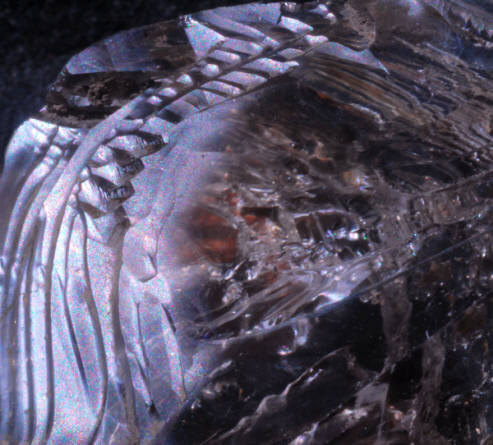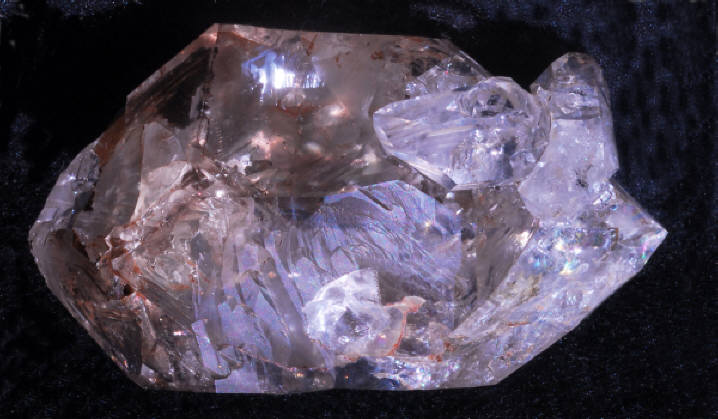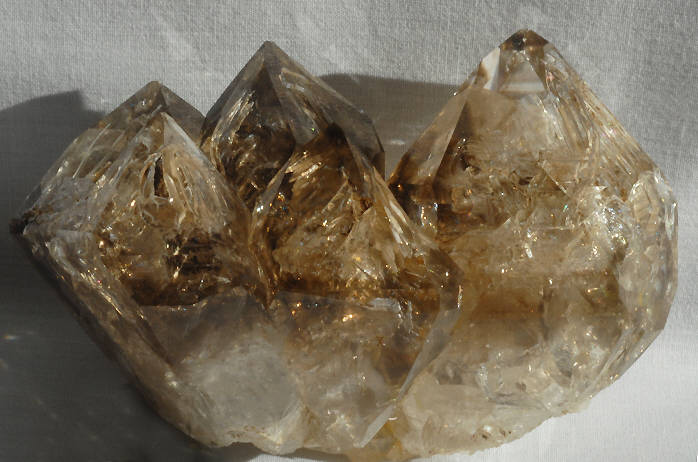Quartz Crystal Habits within Herkimer Diamond Deposits
The best website on"Herkimer Diamonds"
Larger photos of the thumbnails presented on the main "Crystal Form" page. Included is identification information and the source link is embedded there (just click). In some cases additional information and comments are provided for each photo.
Skeletal & Hopper Crystals and Their Features



Hopper crystals from the Herkimer mining district almost alway have some interesting testures or patterns somewhere on the crystal. The above photos show the most common feature - the step like pattern down the face of the crystal, toward the middle.
Below (left) is a regular camera photo from the above hopper crystal showing "pine tree" melting/healing texture textures, sort of what it looks like to the naked eye. Second to the step like pattern the "pine tree" texture is the most common texture seen associated with skeletal and hopper crystals. The rainbow is due to a fracture under the texture that is refracting light. Below right is a microsope photo of "pine tree texture.



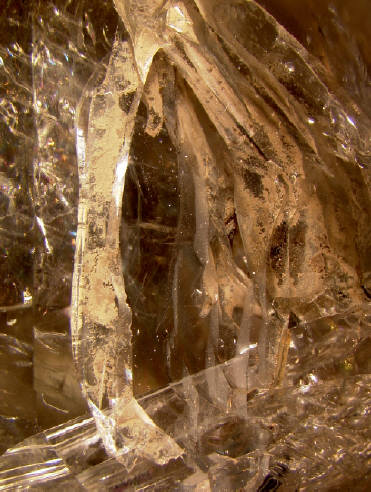
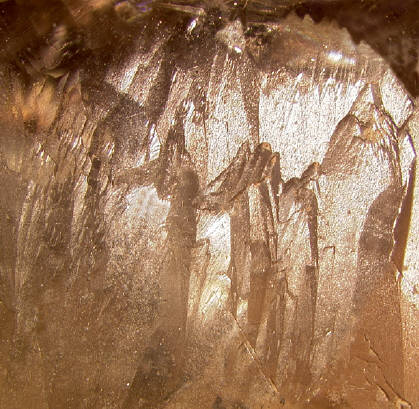
Thus far, every deposit in the Herkimer mining district has either skeletal or hopper crystals, or both. This means that the conditions for making such crystals is a feature consistant across the district, much in the same way the the black carbon and material baby floater druze is consistent across the district. And both are directly related to developing a reasonable history explaining the development of Herkimer diamonds.
The best way to think about hopper/skeletal crystals is to think about crystals being "forced" to grow very rapidly. This can happen when the solution is supersaturated, meaning it has alot of quartz disolved in it. What then happens is that the edges of the crystals grow faster then the faces, giving you this step like "skeleton". But the solution is not continually stable so we get face development alternating with edge development and sometimes the face development wins and the outside of the crystal is formed over the top of an "inside skelton". This fluctuating, unstable, nature of the fluid is also important in terms of understanding how clear Herkimer diamonds happen (see the FAQ) page. There was a dynamic interplay in the Herkimer district between the following conditions: 1) the saturation of the mineral forming solutions, 2) the space available to grow, and 3) the amount of oil/gas present and its timing in connection to the mineral bearing fluids.
We also know from field evidence that there was a late Herkimer "healing" quartz event. There are fractured Herkimer diamonds that are totally "healed" (see the inclusions page). Some of the skeletal crystal features may be the result of this process (a hopper crystal that was healed), but there is still more research that needs to be done. 2009 field work at TCR suggests that when the later quartz healing event encountered a hopper crystal that it tended to form multiple parallel growth crystals over the earlier hopper as the solution strugles to decide which surfaces to actually grow from. A photo of this "skeletal/hopper parallel growth" is shown below (although better examples exist, and could be photographed).
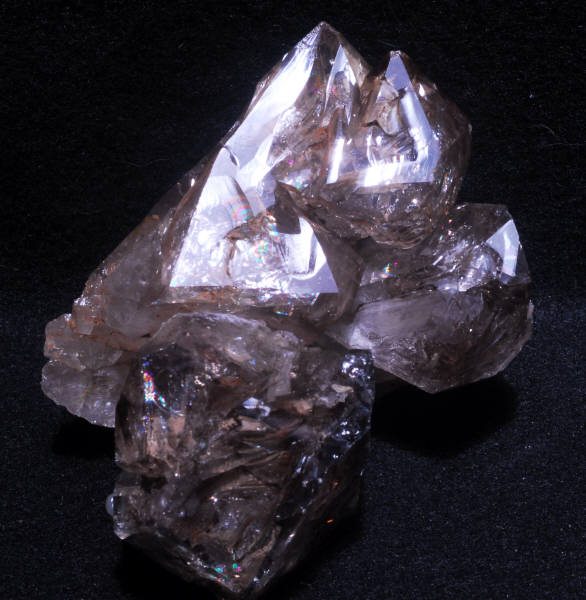
The specimen below shows another feature that may be unique to the TCR location - white solid Herkimer diamonds as the core for growing a skeletal/hopper. This specimen, was donated by the mine owner, measures 10 cm across (photo Dr. D., 2010).
The photo is of the bottom of a crystal. Note the hexagonal shaped hole. Here sat a white Herkimer diamond. Note also the step like growth pattern concentric around the hole.
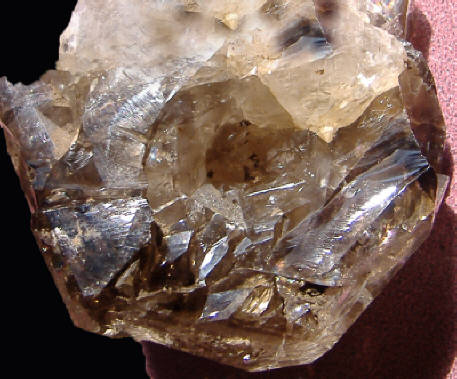
What does the information from these specimens tell us?
The first thing is that we might need to pay more careful attention to the growth patterns associated with hopper crystals from all the deposits. Do any of the other deposits show these features described above? Do they show features unique to only that deposit?
It is to early to say that the TCR location is the only deposit to display these features.
Hole where core Herkimer diamond used to be located
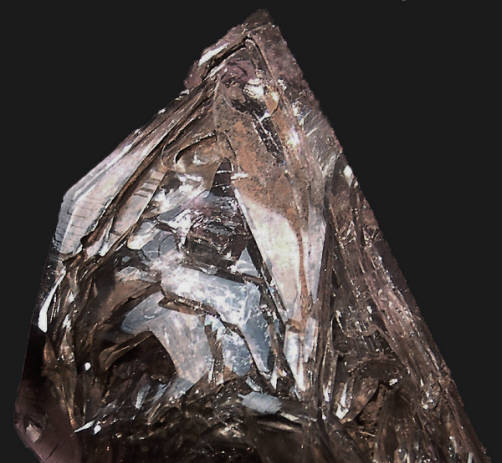
The specimen to the left shows another feature that may be unique to the TCR location - clear, gemmy, step hopper growth. The growth often has a light smoky color. This specimen, damaged, was donated by the mine owner, measures 10 cm top to bottom (photo Dr. D., 2009).
Some specimens from TCR have a combination of both the parallel growth and the gemmy step pattern and this results in specimens of unique attractiveness.
One photo of this unique type of specimen is shown below, from the mine owner's collection. Note the sharp face development, the gem clarity, and the smoky color. Specimen is 12 cm across. Photo Dr. D. 2010.
Hopper crystal textures and patterns
After the step pattern (which can be seen in the photo on the left as big arched steps on the lower left and also a series of lines in the upper right) and the "pine tree" texture (shown int the above photos), the third most common texture is "scalloped etching".
The photo, taken with a macro lens, is 4 cm across and from TCR (donated by the mine owner). Arrow points to the scalloped etching. Photo DrD, 2010.
